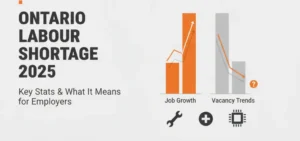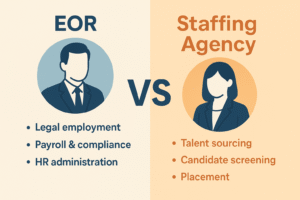A concerning new report reveals a significant challenge brewing in Ontario workplaces. Nearly one in three employees feels uninspired by their work, and a staggering 30% are actively considering leaving their jobs. This isn’t just a fleeting trend; it’s a clear signal that the post-pandemic leniency around “quiet quitting” is ending, replaced by a tangible desire for more fulfilling and supportive work environments.
For business owners and HR leaders, these numbers are a wake-up call. Ignoring this growing wave of disengagement is a direct threat to productivity, innovation, and retention. It’s time to shift from passive observation to proactive employee engagement strategies that genuinely address what your team is looking for.
The Real Story Behind the Numbers
The recent workforce survey paints a stark picture. While headlines might focus on the 30% of employees ready to walk away, the more profound issue is the underlying current of dissatisfaction. Employees are no longer content to simply collect a paycheck; they are seeking purpose, growth, and a positive workplace culture.
What’s driving this shift? Several factors are at play:
- Stagnant Growth: Many employees feel their career progression has stalled. They see fewer opportunities for internal advancement and are looking elsewhere to build their skills and climb the ladder.
- Work-Life Imbalance: The lines between work and home remain blurred for many. Heavy workloads and a lack of clear boundaries are leading to burnout, pushing employees to seek roles that respect their personal time.
- Lack of Recognition: A simple “thank you” goes a long way, but many workers feel their contributions are overlooked. This lack of appreciation leaves them feeling like a cog in a machine rather than a valued team member.
This isn’t just a problem for large corporations. Small and medium-sized businesses in Ontario are particularly vulnerable. Losing a key employee can have a much greater impact, disrupting operations and team morale.
Rethinking Your Employee Engagement Strategies
To combat this trend, businesses must move beyond superficial perks. A ping-pong table in the breakroom won’t fix a toxic culture or a dead-end job. Effective employee engagement strategies are about creating a workplace where people feel connected, valued, and motivated to contribute their best work.
“True engagement isn’t about keeping employees busy. It’s about creating an environment where they are inspired to be their best and see a future with your company.”
Here’s how you can start making meaningful changes that resonate with your team and encourage them to stay and thrive.
1. Foster a Culture of Growth and Development
One of the most powerful retention tools is investing in your people’s future. When employees see a clear path forward within your organization, they are far more likely to stay.
- Create Individual Development Plans (IDPs): Sit down with each employee to discuss their career aspirations. Work together to create a tangible plan with clear milestones for skill development and potential advancement. This shows you are invested in their personal success, not just their current output.
- Promote from Within: Make it a priority to look internally for candidates before posting a job externally. This not only rewards loyal employees but also sends a powerful message to the entire team that hard work and dedication are recognized.
- Offer Learning Opportunities: Provide access to online courses, workshops, or mentorship programs. Subsidizing professional development or offering paid time for learning shows a concrete commitment to their growth.
2. Champion Genuine Work-Life Balance
Burnout is a primary driver of turnover. Actively promoting a healthy balance is essential for long-term employee well-being and engagement.
- Set Clear Expectations: Establish clear guidelines around working hours and communication response times, especially for remote or hybrid teams. Encourage managers to lead by example by disconnecting after hours.
- Offer Flexible Work Arrangements: Where possible, provide flexibility in work hours or location. Allowing an employee to adjust their schedule to handle personal responsibilities can build immense loyalty and reduce stress.
- Encourage PTO Usage: A culture where employees feel guilty taking vacation time is a recipe for burnout. Encourage your team to fully disconnect and recharge, and ensure workloads are managed so they don’t return to an overwhelming pile of work.
3. Build a System of Recognition and Feedback
Employees need to know their work matters. A consistent and authentic approach to recognition is a low-cost, high-impact way to boost morale.
- Implement Regular Check-ins: Move beyond the annual performance review. Implement weekly or bi-weekly one-on-ones where managers can provide real-time feedback and employees can share their challenges and successes.
- Encourage Peer-to-Peer Recognition: Create a simple channel (like a Slack channel or a section in a team meeting) where colleagues can publicly acknowledge each other’s hard work and support.
- Be Specific with Praise: Instead of a generic “good job,” provide specific feedback. For example, “Sarah, the way you handled that difficult client call with such patience and professionalism was outstanding and a great example for the team.”
What Ontario Employers Should Do Next
The data is clear: a passive approach to employee satisfaction is no longer enough. To protect your business from the high costs of turnover and low productivity, you need to act now.
- Launch an Engagement Survey: Don’t assume you know what your employees are thinking. Use a confidential survey to gather honest feedback on what’s working and what isn’t. Ask specific questions about career growth, management support, and work-life balance.
- Train Your Managers: Your frontline managers have the single biggest impact on an employee’s daily experience. Invest in training them on how to provide effective feedback, recognize their team members, and support employee development.
- Commit to One Tangible Change: Based on your survey feedback, choose one meaningful area to improve immediately. Whether it’s creating development plans or clarifying your work-from-home policy, taking swift, visible action shows your team you are listening and serious about change.
By implementing robust employee engagement strategies, you can build a workplace that not only keeps its top talent but also attracts it.
Need help navigating HR changes? Book your free HR audit today or speak with our team about how Divino can support your business.
Sources
- HRD Canada. (2025). 1 in 3 workers uninspired; 3 in 10 want to leave their job: report. Retrieved from https://www.hcamag.com/ca/news/general
- Statistics Canada. (2025). Labour Force Survey, August 2025. Retrieved from https://www150.statcan.gc.ca/n1/daily-quotidien/250905/dq250905a-eng.htm




